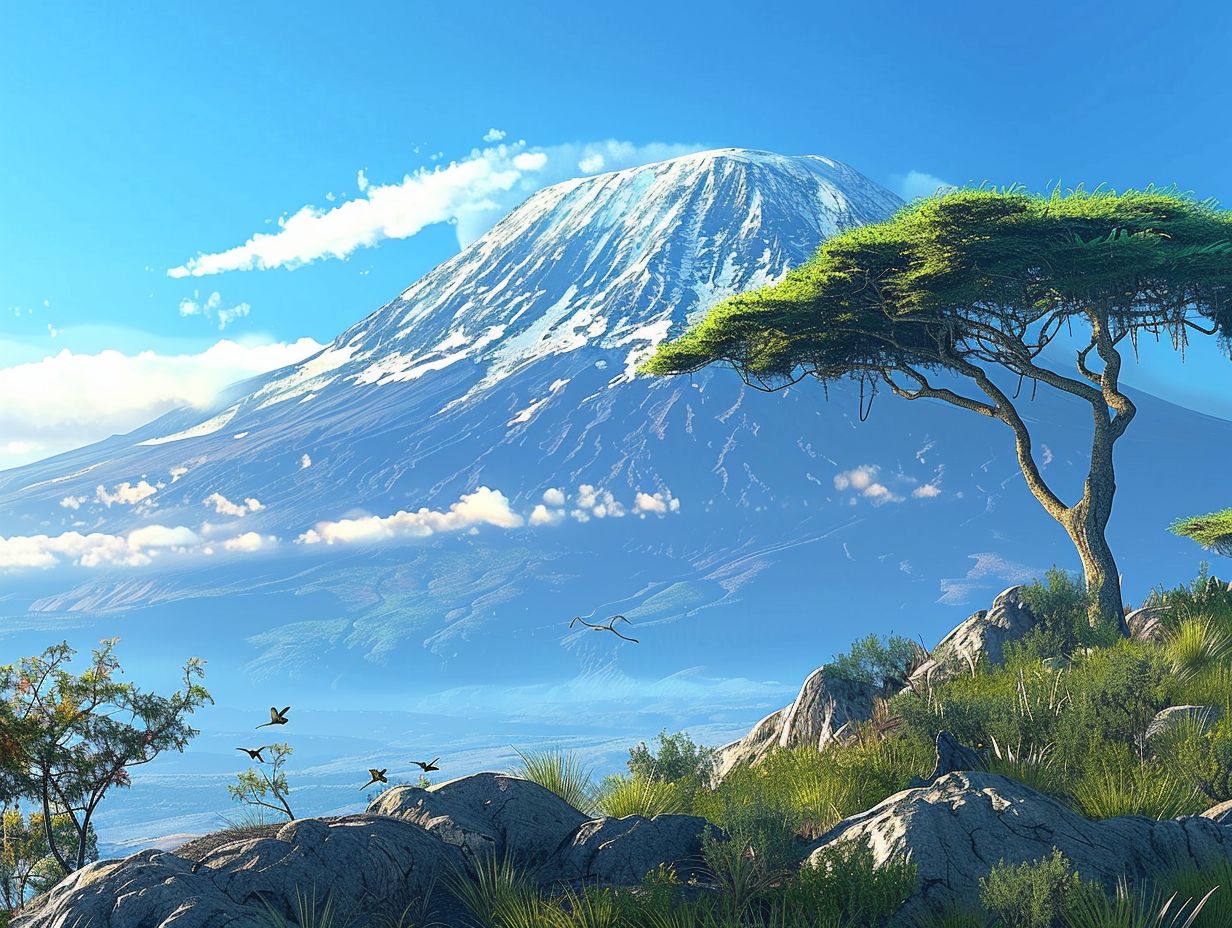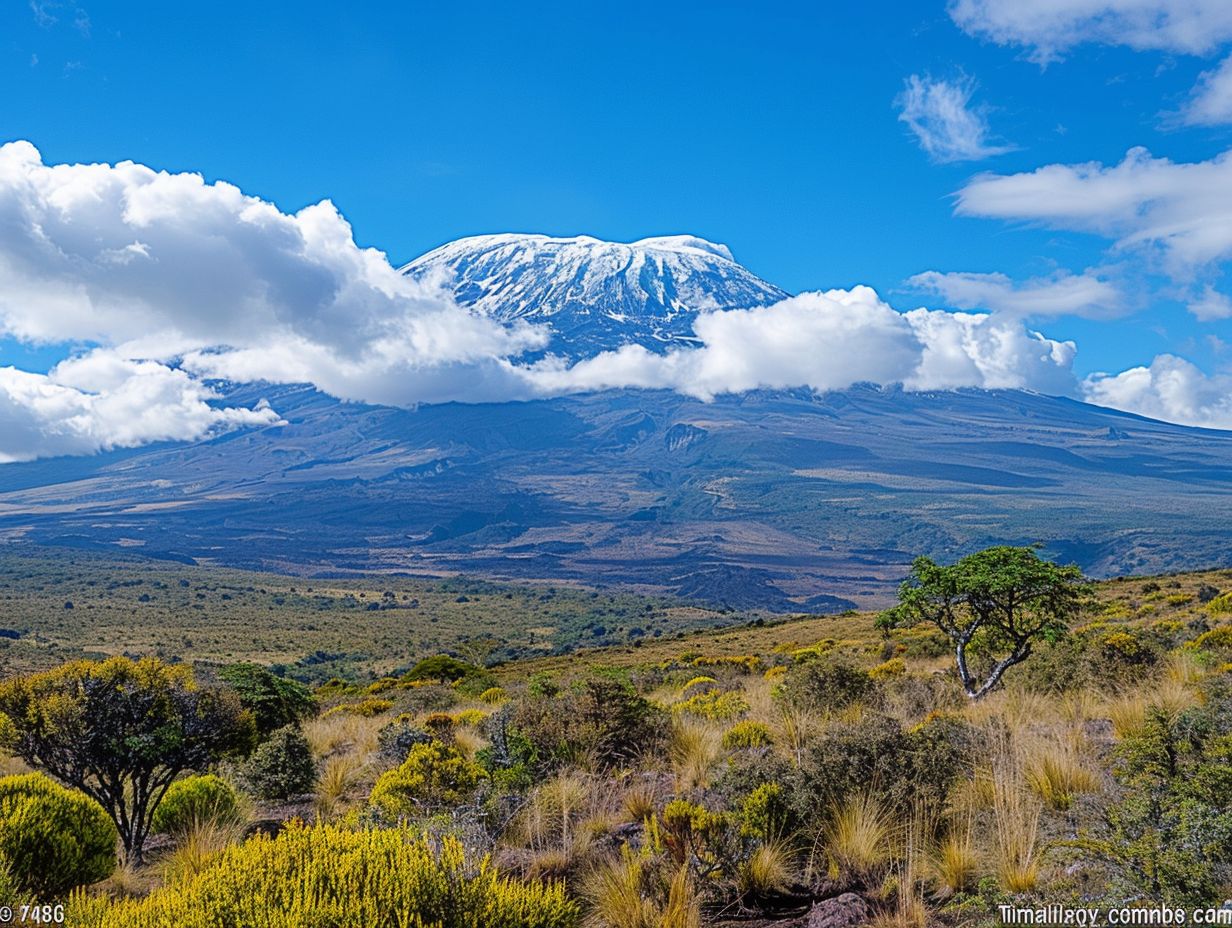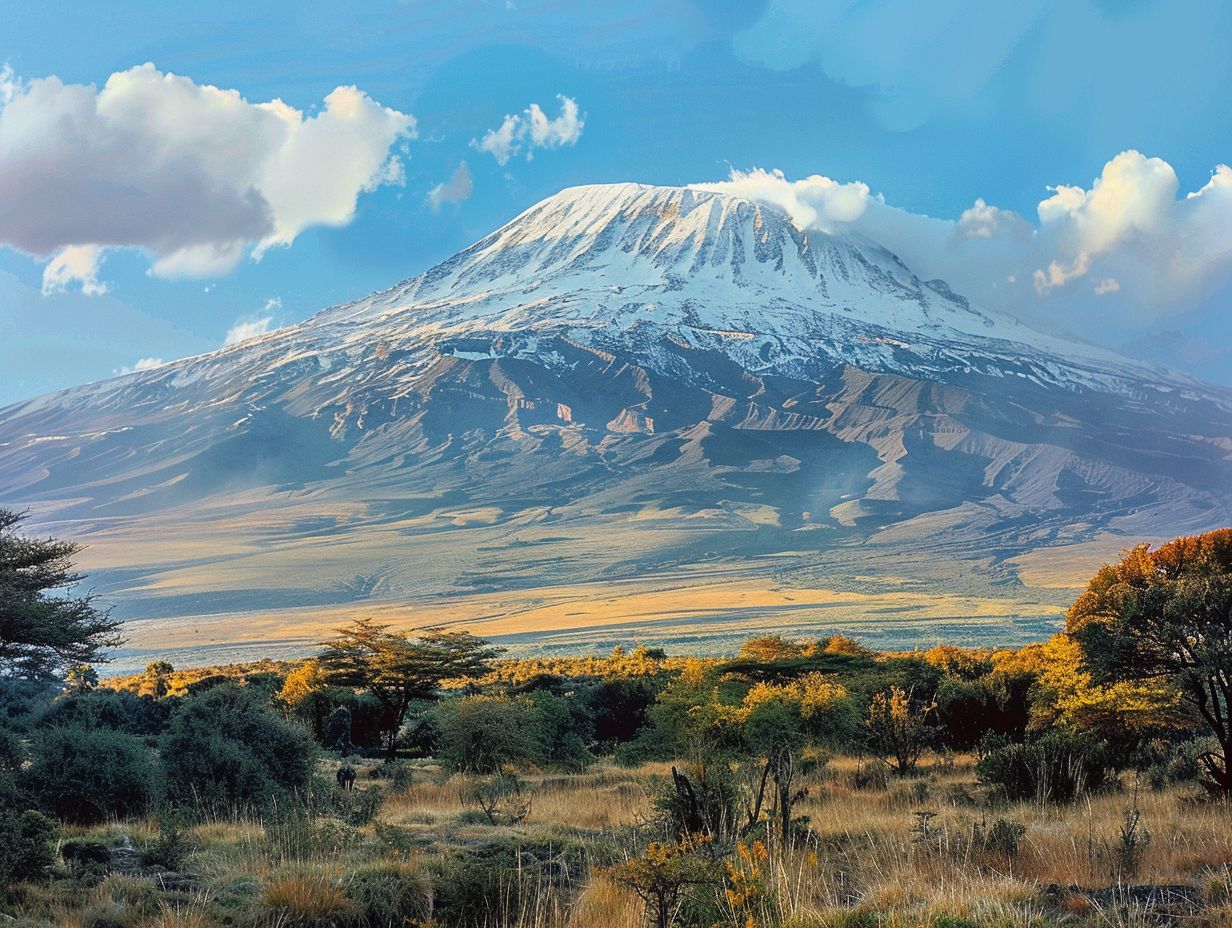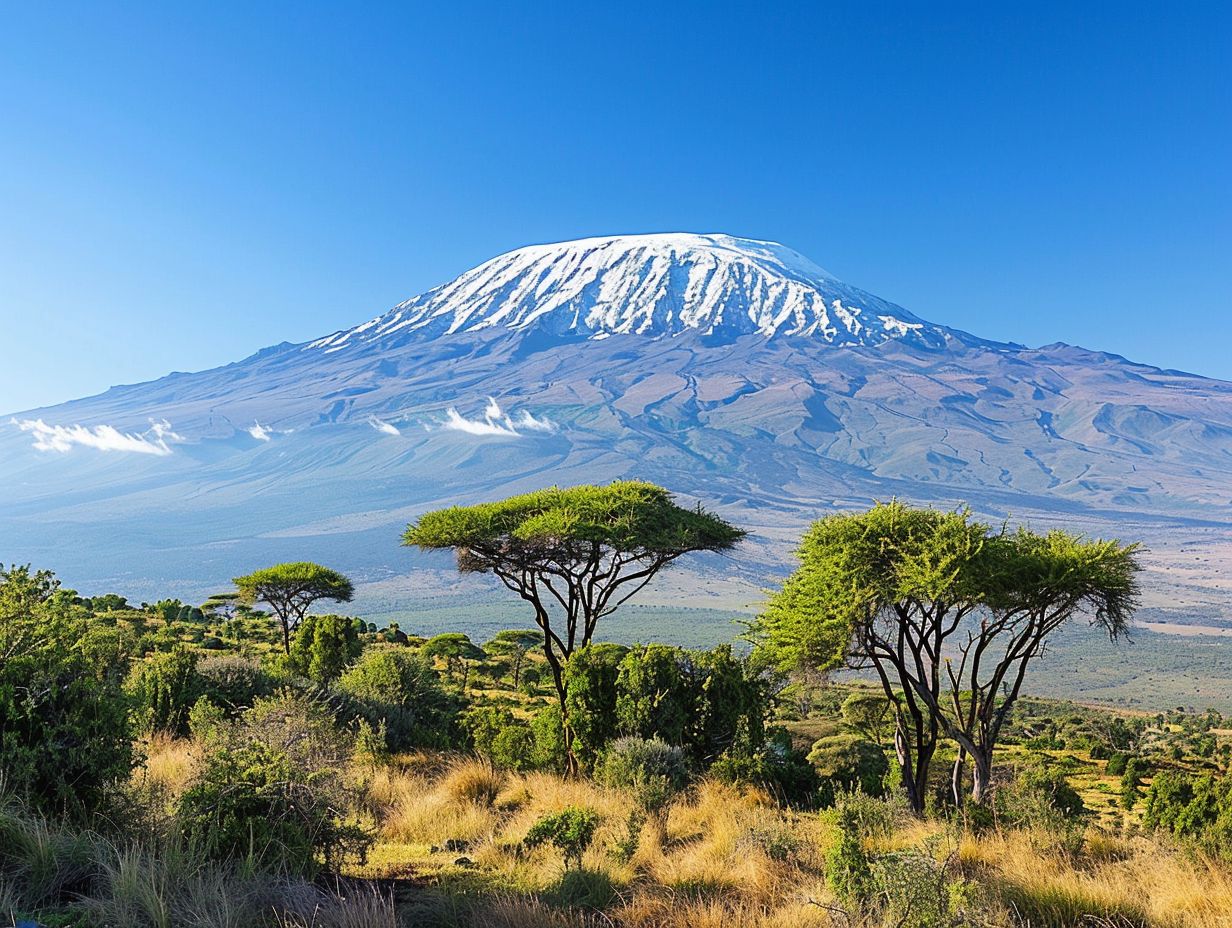
Mount Kilimanjaro, the iconic peak in Tanzania, is a majestic sight that captures the imagination of adventurers and nature lovers alike.
In this article, we will explore the height of Mount Kilimanjaro and how it compares to other mountains around the world. We will also delve into why Mount Kilimanjaro is famous and why it attracts climbers from all corners of the globe.
We will discuss the different routes to climb the mountain, the physical challenges faced by climbers, and how they prepare for the journey ahead.
Join us as we uncover the fascinating world of Mount Kilimanjaro and all it has to offer.
Key Takeaways:

- Mount Kilimanjaro is 19,341 feet tall, making it the tallest mountain in Africa and one of the Seven Summits.
- The tallest mountain in the world is Mount Everest, standing at 29,029 feet. Mount Kilimanjaro ranks as the fourth tallest mountain in the world.
- Mount Kilimanjaro is renowned for its unique ecosystem and being a popular destination for climbers due to its accessibility and diverse landscapes.
What Is the Height of Mount Kilimanjaro?
Mount Kilimanjaro, located in Tanzania, is the highest mountain in Africa, with its summit, Uhuru Peak, reaching an altitude of 5,895 meters (19,341 feet) above sea level.
The altitude of Mount Kilimanjaro makes it a prominent feature not only in Africa but globally. Rising majestically from the surrounding plains, the peak stands as a symbol of physical endurance and natural wonder.
At its summit, Uhuru Peak offers breathtaking panoramic views of vast expanses below and the feeling of standing on the ‘Roof of Africa.’ The summit boasts a unique combination of glaciers, volcanic cones, and rocky formations, attracting experienced climbers and adventurers from around the world seeking to conquer its challenging terrain.
How Has the Height of Mount Kilimanjaro Been Measured?
The height of Mount Kilimanjaro has been measured using various techniques including geodetic surveys, topographic maps, and modern satellite-based methods, with early expeditions by climbers and geologists contributing to the understanding of its geological structure.
Geodetic surveys involve precise measurements of large areas using trigonometry and satellite technology, while topographic maps provide detailed elevation information for specific regions. Satellite-based methods such as radar and LiDAR have revolutionized height measurements, allowing for accurate and up-to-date data on Mount Kilimanjaro’s peak.
These measurements are crucial in understanding the mountain’s geological significance, revealing shifts in tectonic plates and volcanic activity that have shaped its formation over millions of years.
Past expeditions to Mount Kilimanjaro have played a vital role in unraveling the mysteries of its geological history. Early climbers and geologists braved the challenging terrain to collect rock samples, study fossils, and document the layers of sedimentation found on the slopes.
Their findings have provided valuable insights into the mountain’s formation, including evidence of past volcanic eruptions and glacial movements that have sculpted its iconic silhouette.
How Does Mount Kilimanjaro Compare to Other Mountains?
In comparison to other mountains worldwide, Mount Kilimanjaro stands out as the highest peak in Africa, while mountains like Mount Everest claim the title of the highest peak globally, showcasing the diverse range of mountainous terrain across different continents.
While Mount Everest towers as the highest peak in the Himalayas and the world, reaching a soaring height of 8,848 meters above sea level, Mount Kilimanjaro makes its mark as the tallest freestanding mountain globally, with its Uhuru Peak standing at 5,895 meters. This stark contrast in peak heights differentiates the two famous mountains significantly.
What sets Mount Kilimanjaro apart from its counterparts is its unique position in the African landscape. Rising majestically on the African continent in Tanzania, Kilimanjaro presents a distinct challenge and allure to climbers and adventurers, with its snow-capped summit standing as a beacon of natural beauty in the heart of Africa.
What Is the Tallest Mountain in the World?
Mount Everest, located in the Himalayas, is renowned as the tallest mountain in the world, boasting an impressive peak altitude of 8,848.86 meters (29,031.7 feet) above sea level, attracting climbers and geologists alike due to its challenging terrain and geological significance.
Its rocky surface is covered in snow almost year-round, creating a stunning contrast against the deep blue sky. The geological composition of Mount Everest is predominantly metamorphic rocks, including marble and phyllite, which were formed millions of years ago through intense pressure and heat.
As climbers ascend the mountain, they encounter various challenges, from treacherous crevasses to unpredictable weather conditions. The allure of conquering the world’s highest peak drives many experienced climbers to attempt the daunting journey to the summit.
How Does Mount Kilimanjaro Rank Among the Tallest Mountains?

While Mount Kilimanjaro ranks as the highest peak in Africa, it holds a distinct position in the global mountain hierarchy, standing as a prominent landmark alongside towering giants like Mount Everest, showcasing the rich diversity of mountainous landscapes on Earth.
Reaching an impressive height of about 19,341 feet (5,895 meters), Kilimanjaro’s snow-capped peak majestically overlooks the African savannahs below. In comparison, Mount Everest, the highest peak globally, towers at approximately 29,032 feet (8,848 meters). Despite its slightly lower elevation, Kilimanjaro’s captivating presence and ecological significance make it renowned worldwide.
Why Is Mount Kilimanjaro Famous?
Mount Kilimanjaro has garnered fame worldwide for its iconic status as the highest peak in Africa, attracting climbers and trekkers seeking to conquer its summit and witness the breathtaking views from Uhuru Peak, making it a popular destination for adventurers and nature enthusiasts.
The allure of Mount Kilimanjaro lies not only in its impressive elevation but also in its diverse landscapes and microclimates that climbers encounter as they ascend the mountain. From lush rainforests to alpine deserts, the journey to the summit offers a unique experience and a sense of accomplishment to those who reach the top.
The challenge of scaling the peak, coupled with the chance to stand on Africa’s rooftop, makes Kilimanjaro a bucket list item for many outdoor enthusiasts. The rich cultural significance of the mountain to the local Chagga people adds a compelling layer of history and tradition to the adventure.
What Makes Mount Kilimanjaro a Popular Destination for Climbers?
Mount Kilimanjaro’s popularity among climbers stems from its accessibility, diverse trekking routes catering to different skill levels, the sense of achievement associated with successfully summiting Uhuru Peak, and the stunning landscapes encountered along the journey, making it a sought-after destination for aspiring and seasoned mountaineers.
One of the key factors that contribute to the allure of Mount Kilimanjaro is its strategic location in Tanzania, offering a relatively more accessible climb compared to other major peaks. The presence of multiple trekking routes, such as the Machame Route, Marangu Route, Lemosho Route, and Rongai Route, ensures that climbers can choose paths that match their expertise and preferences.
The summit success rates on Kilimanjaro are relatively high, thanks to gradual altitude acclimatization and experienced guides who accompany expedition groups. Climbers revel in the sense of accomplishment that comes with standing on the roof of Africa at the summit, Uhuru Peak, the highest point on the continent.
The journey to the top of Kilimanjaro is not just physically demanding but also visually captivating, with ever-changing landscapes, from lush rainforests to barren alpine deserts, offering a truly unique and enriching experience for those who undertake the challenge.
What Are Some Interesting Facts About Mount Kilimanjaro?
Mount Kilimanjaro, a dormant volcano, is renowned for its three volcanic cones: Kibo, Mawenzi, and Shira, as well as its extensive ice fields and glaciers that have been gradually retreating over the years, showcasing the geological and climatic diversity of this iconic African mountain.
Standing majestically at over 19,000 feet, Mount Kilimanjaro is not only the highest peak in Africa but also the tallest freestanding mountain in the world, drawing climbers and adventurers from all corners of the globe.
The mountain’s volcanic origins date back to its formation around a million years ago, with its last major eruption occurring some 360,000 years ago, shaping the distinctive peaks that we see today. The effects of climate change are starkly visible on the glaciers of Kilimanjaro, with studies indicating that they have decreased by around 85% since 1912 due to rising temperatures.
What Are the Different Routes to Climb Mount Kilimanjaro?
Mount Kilimanjaro offers various climbing routes, each presenting unique challenges and scenic experiences, catering to climbers of different preferences and skill levels, with popular routes like the Machame Route, Lemosho Route, and Marangu Route attracting adventurers from around the globe.
Each of these routes has its own distinct characteristics that make them appealing to different types of climbers.
- The Machame Route, often referred to as the ‘Whiskey Route,’ is known for its stunning scenery and diverse landscapes, providing a challenging yet rewarding trek through lush rainforests, moorlands, and alpine deserts.
- In contrast, the Lemosho Route is considered one of the most scenic options, offering a longer and more gradual ascent, allowing climbers to acclimatize better and enjoy breathtaking views along the way.
Which Route Is the Most Popular?

Among the numerous routes on Mount Kilimanjaro, the Machame Route stands out as one of the most popular choices for climbers, known for its scenic beauty, gradual ascent profile, and higher summit success rates, attracting adventurers seeking a memorable and rewarding climbing experience.
One of the unique features of the Machame Route is its opportunity to experience a variety of landscapes, including dense rainforest, moorland, alpine desert, and glaciers, offering climbers a diverse and visually captivating journey.
The success factors contributing to its popularity include a well-planned itinerary that allows for proper acclimatization, well-maintained campsites with amenities, and professional guides who ensure the safety and comfort of climbers.
The overall appeal of the Machame Route lies in the balance it strikes between challenge and accessibility, providing a challenging yet achievable trek that rewards climbers with breathtaking views and a sense of accomplishment at the summit of Africa’s highest peak.
Which Route Is the Most Challenging?
For climbers seeking a more challenging ascent, the Western Breach Route on Mount Kilimanjaro presents a formidable option, characterized by steep terrain, technical sections, and an adventurous approach to reaching the summit, attracting experienced mountaineers looking for a thrilling and demanding climb.
The Western Breach Route, known for its rugged nature, pushes climbers to their limits as they navigate through the challenging Barranco Wall, a steep rock scramble requiring agility and skill.
At an elevation of over 19,000 feet, the route also poses significant altitude-related challenges, demanding proper acclimatization and endurance from those attempting the climb.
Despite the strenuous nature of the route, its allure lies in the sense of accomplishment and breathtaking views it offers to those brave enough to take on this arduous expedition.
What Are the Physical Challenges of Climbing Mount Kilimanjaro?
Climbing Mount Kilimanjaro presents climbers with various physical challenges, including altitude sickness due to the rapid gain in elevation, common injuries such as frostbite and sprains, and the demanding physical exertion required throughout the ascent to the summit.
Altitude sickness, also known as acute mountain sickness (AMS), is a common issue faced by climbers as they ascend Kilimanjaro. Symptoms can range from mild headaches and fatigue to more severe cases of pulmonary or cerebral edema. These conditions can be life-threatening and require immediate descent to lower altitudes for treatment.
The extreme temperatures on the mountain can lead to frostbite, particularly affecting fingers, toes, and the nose. Climbers must be vigilant about keeping all parts of their body warm and dry to prevent such injuries.
Plus these health risks, the physical demands of climbing Kilimanjaro cannot be understated. The terrain is often steep and rugged, requiring strength, stamina, and agility. Proper preparation through physical training and acclimatization is essential to increase the chances of a successful summit attempt.
How Does Altitude Sickness Affect Climbers?
Altitude sickness, a common challenge faced by climbers on Mount Kilimanjaro, manifests in symptoms like headaches, nausea, and fatigue as the body adjusts to higher altitudes, posing a significant risk to climbers’ health and requiring proper acclimatization strategies to mitigate its impact.
When climbers ascend rapidly to higher altitudes, the decrease in oxygen levels can lead to altitude sickness, affecting individuals differently. In severe cases, altitude sickness can progress to High Altitude Cerebral Edema (HACE) or High Altitude Pulmonary Edema (HAPE), both life-threatening conditions.
Common preventive measures include gradual ascent, proper hydration, adequate rest, and a balanced diet rich in carbohydrates and hydration. Climbers are also advised to recognize the symptoms promptly, which may include dizziness, shortness of breath, and loss of appetite.
What Are Some Common Injuries on Mount Kilimanjaro?
Common injuries experienced by climbers on Mount Kilimanjaro include frostbite from extreme cold conditions, sprains due to rugged terrain, and exhaustion-related ailments, highlighting the physical risks associated with high-altitude mountaineering and the need for caution during the ascent.
Among these common injuries, frostbite is a serious concern due to the subzero temperatures encountered at higher altitudes. Frostbite occurs when skin and underlying tissues freeze, leading to numbness, discoloration, and possibly permanent damage if not treated promptly. Sprains often result from the challenging terrain on Kilimanjaro, putting stress on muscles and ligaments.
Proper gear, such as sturdy footwear and trekking poles, can help reduce the risk of these injuries. It is crucial for climbers to acclimate properly, stay hydrated, and recognize early signs of altitude sickness to prevent health complications during the climb.
How Do Climbers Prepare Physically for the Climb?

To tackle the physical challenges of climbing Mount Kilimanjaro, climbers engage in rigorous training regimes encompassing cardiovascular exercises, strength training, and altitude simulation to improve their endurance, stamina, and overall fitness levels, enhancing their preparedness for the demanding expedition ahead.
Climbers focus on altitude acclimatization strategies to mitigate the risks associated with high altitudes, such as gradual ascent protocols and hydration practices. They also prioritize mental preparedness through yoga, meditation, and visualizing the climb to build resilience against the mental toll of the journey.
A crucial aspect of their training routine involves frequent hiking excursions on challenging terrains to simulate the conditions they will face on the actual climb, ensuring that they are well-equipped physically and mentally for the varying landscapes and unpredictable weather on Kilimanjaro.
Frequently Asked Questions
How tall is Mount Kilimanjaro?
Mount Kilimanjaro is 5,895 meters (19,340 feet) tall, making it the highest mountain in Africa and the tallest freestanding mountain in the world.
What is the elevation of Mount Kilimanjaro?
The elevation of Mount Kilimanjaro is 5,895 meters (19,340 feet) above sea level.
Where is Mount Kilimanjaro located?
Mount Kilimanjaro is located in Tanzania, a country in East Africa. It is situated near the border of Tanzania and Kenya.
How long does it take to climb Mount Kilimanjaro?
The time it takes to climb Mount Kilimanjaro varies depending on the route and the individual’s fitness level. On average, it takes 6-8 days to reach the summit.
Can anyone climb Mount Kilimanjaro?
While no technical climbing skills are required, climbing Mount Kilimanjaro is a physically demanding activity. It is recommended to be in good physical shape and to acclimatize properly before attempting the climb.
Is it safe to climb Mount Kilimanjaro?
Climbing Mount Kilimanjaro can be dangerous due to changing weather conditions, high altitude, and physical exertion. However, with proper preparation and a knowledgeable guide, it can be a safe and rewarding experience.